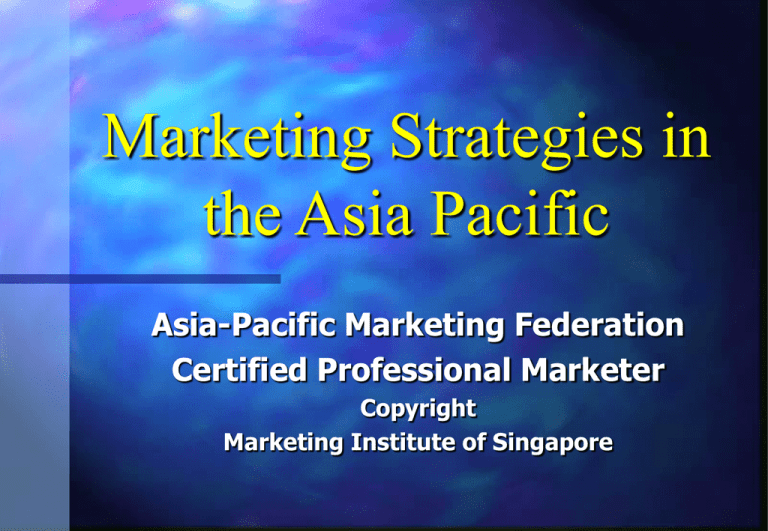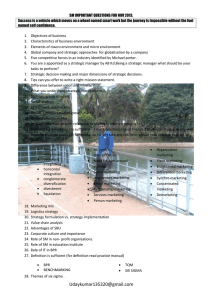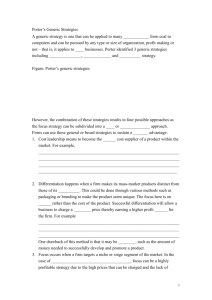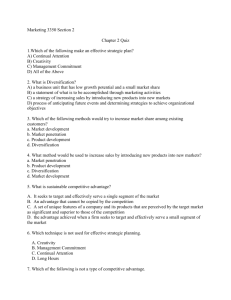Marketing Strategies in the Asia Pacific
advertisement

Marketing Strategies in the Asia Pacific Asia-Pacific Marketing Federation Certified Professional Marketer Copyright Marketing Institute of Singapore Outline Porter’s Three Generic Strategy Growth strategies Ansoff Grid—Product-Market Strategies Market Penetration Strategy Product-Development Strategy Market-Development Strategy Diversification Strategy Introduction Many strategies had been used since time immemorial. Fortunately for us, Prof. Michael Porter had condensed them into 3 generic types Porter’s Three Generic Strategies See next slide: Figure: A model for developing strategic orientation Strategic Orientation— Porter’s Three Generic Strategies Low Cost Position Uniqueness Differentiation Focus Differentiation Overall Cost Leadership Focus Focus Low Cost Strategic Advantages Porter’s Three Generic Strategies Differentiation Achieve superior performance over the competition e.g. Canon uses superior quality to differentiate itself in the photocopying industry Porter’s Three Generic Strategies (cont’d) Overall Low Cost Achieve the lowest cost in the industry e.g. Naxos in the compact disc field Focus Either focus differentiation or focus low cost by concentrating on a narrow segment of the market e.g. Raffles Hotel (Source: Marketing Management, 2nd Ed. 1999, Philip Kotler et. al.) Growth Strategies Three Major classes Intensive Growth Market penetration, market development & product development (see next slide) Integrative Growth Backward, forward & horizontal integration Diversification Growth Concentric, horizontal and conglomerate Source: Marketing Management, 2nd Ed. 1999, Philip Kotler et. al. Ansoff Matrix— Product-Market Strategies Existing Existing New Market Penetration Market Development (Expansion) New Product Development (Expansion) Diversification Market-Penetration Strategy Why ? How ? To dominate market To increase usage or get new customers; reduce price; expand distribution or increase promotional activities When ? When market is growing What to look out for ? Competitive reaction; cost of conversion Example: Airlines used reduced fares & promotion various family travel packages to penetrate market Product-Development Strategy Why ? To satisfy buyer’s need How ? New or improved product; innovate or augment product When ? Customer has a need or a problem What to look out for ? Market size/volume competitor reaction effect on existing products resources to deliver new products Examples: Acer; Soundblaster 1,2,3 Market-Development Strategy Why ? How ? To venture into new markets Sell existing products in new markets; modify product; use different distribution; use different advertising/sales strategy When ? Present market is saturated What to look out for ? Competitive reaction; understand new buyers; adaptability Example: Hong Kong and China Gas (Towngas) is to invest HK$2 billion in the transmission of natural gas in China, in a continued bid to expand away from its base in Hong Kong. (Source: SCMP; June 29, 2001) Diversification Strategy Why ? Growth opportunities outside current business How ? New products for new markets When ? Distinctive competencies available What to look out for ? High risks, resources required, need to understand new markets, fit with distinctive competencies Examples: In July 1997, DBS Land diversified into Healthcare by acquiring a stake in Parkway Holdings, a leading healthcare provider in Asia and in 1999, DBS Land bought into Vista Healthcare Diversification Strategy (cont’d) Three types of diversification Concentric, horizontal and conglomerate Three essential tests of success Attractiveness Cost-of-entry Better-off PIMS findings on diversification Not very encouraging Vertical Integration Why? To gain operating economies i.e. to lower costs To gain access to or control supply demand To enhance technological innovation How? Integrate backward and forward When? Basic industry is in a growth stage What to look out for? Problems in managing very different businesses; increase risk, reduced flexibility; cost of excessive in-growing Example of Vertical Integration Japanese keiretsu systems Korean chaebols Airlines integrate backward to in-flight kitchens; forward to travel agencies









